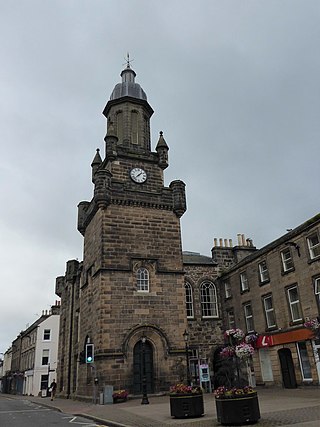
Forres is a town and former royal burgh in the north of Scotland on the Moray coast, approximately 25 miles (40 km) northeast of Inverness and 12 miles (19 km) west of Elgin. Forres has been a winner of the Scotland in Bloom award on several occasions. There are many geographical and historical attractions nearby such as the River Findhorn, and there are also classical, historical artifacts and monuments within the town itself, such as Forres Tolbooth and Nelson's Tower. Brodie Castle, the home of the Brodie Clan, lies to the west of the town, close to the A96.

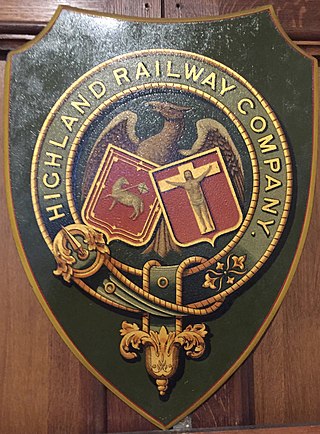
The Highland Railway (HR) was one of the smaller British railways before the Railways Act 1921, operating north of Perth railway station in Scotland and serving the farthest north of Britain. Based in Inverness, the company was formed by merger in 1865, absorbing over 249 miles (401 km) of line. It continued to expand, reaching Wick and Thurso in the north and Kyle of Lochalsh in the west, eventually serving the counties of Caithness, Sutherland, Ross & Cromarty, Inverness, Perth, Nairn, Moray and Banff. Southward it connected with the Caledonian Railway at Stanley Junction, north of Perth, and eastward with the Great North of Scotland Railway at Boat of Garten, Elgin, Keith and Portessie.

The Highland Main Line is a railway line in Scotland. It is 118 mi (190 km) long and runs through the central Scottish Highlands, mainly following the route of the A9, and linking a series of small towns and villages with Perth at one end and Inverness at the other. Today, services between Inverness and Edinburgh, Glasgow and London use the line. At Inverness the line connects with the Far North Line, the Aberdeen-Inverness Line and the Kyle of Lochalsh Line. All trains are diesel-powered.

The Glenfinnan Viaduct is a railway viaduct on the West Highland Line in Glenfinnan, Inverness-shire, Scotland, built from 1897 to 1901. Located at the top of Loch Shiel in the West Scottish Highlands, the viaduct overlooks the Glenfinnan Monument and the waters of Loch Shiel.
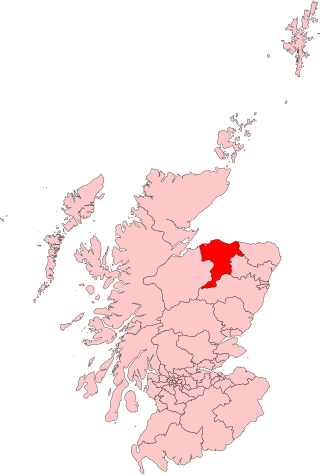
Moray is a county constituency of the House of Commons of the Parliament of the United Kingdom. It elects one Member of Parliament (MP) by the first past the post system of election.

The Aberdeen–Inverness line is a railway line in Scotland linking Aberdeen and Inverness. It is not electrified. Most of the line is single-track, other than passing places and longer double-track sections between Insch and Kennethmont and Inverurie and Berryden Junction (Aberdeen).
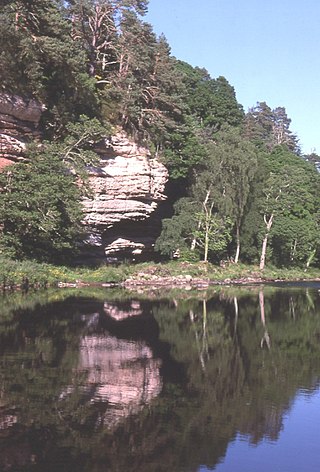
The River Findhorn is one of the longest rivers in Scotland. Located in the north east, it flows into the Moray Firth on the north coast. It has one of the largest non-firth estuaries in Scotland.

Nairn railway station is a railway station serving the town of Nairn in Scotland. The station is managed and served by ScotRail and is on the Aberdeen to Inverness Line, between Forres and Inverness Airport, measured 128 miles 72 chains (207.4 km) from Perth via the former Dava route. It is a category B listed building.

Elgin railway station is a railway station serving the town of Elgin, Moray in Scotland. The station is managed and served by ScotRail and is on the Aberdeen to Inverness Line, between Keith and Forres, measured 12 miles 18 chains (19.7 km) from Forres.
The Inverness and Aviemore Direct Railway was a section of railway built by the Highland Railway to provide a shorter and more direct route between Inverness and Aviemore, carrying its main line traffic to Perth and the south.
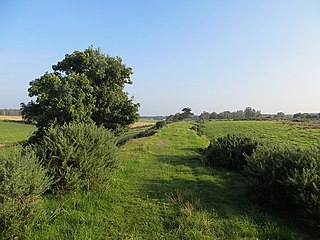
The Inverness and Perth Junction Railway (I&PJR) was a railway company that built a line providing a more direct route between Inverness and the south for passengers and goods. Up to the time of its opening, the only route was a circuitous way through Aberdeen. The I&PJR was built from a junction with the friendly Inverness and Aberdeen Junction Railway at Forres to the Perth and Dunkeld Railway at Dunkeld.
The Inverness and Aberdeen Junction Railway (I&AJR) was a railway company in Scotland, created to connect other railways and complete the route between Inverness and Aberdeen. The Inverness and Nairn Railway had opened to the public on 7 November 1855 and the Great North of Scotland Railway (GNoSR) was building from Aberdeen to Keith. The I&AJR opened, closing the gap, on 18 August 1856.
The Muckle Spate was a great flood in August 1829, which devastated much of Strathspey, in the north east of Scotland. Muckle is a Scots word for 'much' or 'great'.

The Culloden Viaduct is a railway viaduct on the Highland Main Line, to the east of the city of Inverness, in the Highland council area of Scotland.

The Dava Way is a 38 km (24 mi) long-distance path that mostly follows the route of the former Highland Railway between Grantown and Forres. The railway line, built as a route between Inverness and Perth, opened in 1863 and closed in 1965. The route was reopened as a long distance path in 2005. It is listed as one of Scotland's Great Trails by NatureScot, and links directly to two further Great Trails: the Moray Coast Trail and the Speyside Way. It is currently the shortest of the Great Trails, but can be combined with sections of the Moray Coast Trail and Speyside Way to form a 153 km (95 mi) circular route known as the Moray Way. About 5,000 people use the path every year, of whom about 400 complete the entire route.
Murdoch Paterson was an engineer and architect based in Inverness, Scotland, who was chief engineer of the Highland Railway.

The Findhorn Viaduct is a railway bridge approximately 500 metres (550 yd) east of the village of Tomatin in the Scottish Highlands, which carries the Perth to Inverness railway line over the valley of the River Findhorn.
Findhorn Viaduct is the name given to two separate railway bridges that cross the River Findhorn in Scotland:
















